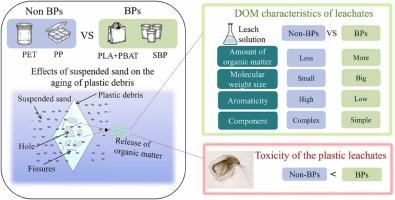不同悬浮砂浓度下老化塑料垃圾渗滤液的动态变化及其毒性
IF 11.3
1区 环境科学与生态学
Q1 ENGINEERING, ENVIRONMENTAL
引用次数: 0
摘要
水生环境中的塑料污染造成了重大的生态风险,特别是通过排放的渗滤液。虽然传统或非生物降解塑料(non- bp)已经得到了很好的研究,但生物降解塑料(bp)已经成为一种替代品,其设计目的是在环境中更快地降解。然而,关于水生环境中老化bp渗滤液的生态风险研究较少。本实验室对照研究了不同老化时间和悬浮砂浓度(0、50、100、250和500 mg/L)下,传统非bp(聚对苯二甲酸乙二醇酯(PET)和聚丙烯(PP))和bp(聚乳酸(PLA) -聚己二酸丁二酯(PBAT)和淀粉基塑料(SBP)的渗滤液释放过程及其相关毒性。结果表明,bp释放的溶解有机碳(DOC)水平明显高于非bp,特别是在悬浮砂浓度升高时。PLA+PBAT渗滤液中DOC浓度达到2.69 mg/L,超过PET和PP, bp释放出分子量较大的有机物和类蛋白物质。毒性试验表明,bp的渗滤液比非bp的渗滤液更能抑制大水蚤的活性。悬浮砂浓度为500 mg/L时,PLA+PBAT渗滤液对大水蚤的抑制率为30%。尽管可降解性增强,但bp的渗滤液可能会增加悬浮砂浓度高的生态系统的环境风险。全面的生态风险评估对于有效管理和减轻塑料污染的危害至关重要。本文章由计算机程序翻译,如有差异,请以英文原文为准。

Dynamic changes of leachates of aged plastic debris under different suspended sand concentrations and their toxicity
Plastic pollution in aquatic environments poses significant ecological risks, particularly through released leachates. While traditional or non-biodegradable plastics (non-BPs) are well-studied, biodegradable plastics (BPs) have emerged as alternatives that are designed to degrade more rapidly within the environment. However, research on the ecological risks of the leachates from aged BPs in aquatic environments is scarce. This controlled laboratory study investigated the leachate release processes and associated toxicity of traditional non-BPs, i.e., polyethylene terephthalate (PET) and polypropylene (PP) and BPs, i.e., polylactic acid (PLA) combined with polybutylene adipate terephthalate (PBAT) and starch-based plastic (SBP) under different aging time and suspended sand concentrations (0, 50, 100, 250, and 500 mg/L). The results indicated that BPs release significantly higher levels of dissolved organic carbon (DOC) than those of non-BPs, particularly at elevated suspended sand concentrations. The DOC concentrations in PLA+PBAT leachate reached 2.69 mg/L, surpassing those of PET and PP. Additionally, BPs released organic matter of larger molecular weight and protein-like substances. Toxicity tests showed that leachates from BPs inhibited the activity of Daphnia magna more than those from non-BPs. At a suspended sand concentration of 500 mg/L, PLA+PBAT leachate caused a 30 % inhibitory rate of Daphnia magna. Despite enhanced degradability, leachates from BPs may pose increased environmental risks in ecosystems with high suspended sand concentrations. Comprehensive ecological risk assessments are essential for effectively managing and mitigating these hazards of plastic pollution.
求助全文
通过发布文献求助,成功后即可免费获取论文全文。
去求助
来源期刊

Journal of Hazardous Materials
工程技术-工程:环境
CiteScore
25.40
自引率
5.90%
发文量
3059
审稿时长
58 days
期刊介绍:
The Journal of Hazardous Materials serves as a global platform for promoting cutting-edge research in the field of Environmental Science and Engineering. Our publication features a wide range of articles, including full-length research papers, review articles, and perspectives, with the aim of enhancing our understanding of the dangers and risks associated with various materials concerning public health and the environment. It is important to note that the term "environmental contaminants" refers specifically to substances that pose hazardous effects through contamination, while excluding those that do not have such impacts on the environment or human health. Moreover, we emphasize the distinction between wastes and hazardous materials in order to provide further clarity on the scope of the journal. We have a keen interest in exploring specific compounds and microbial agents that have adverse effects on the environment.
 求助内容:
求助内容: 应助结果提醒方式:
应助结果提醒方式:


